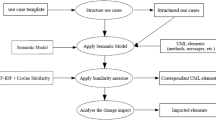Abstract
Bridging software design and business process investigation appears to be a crucial research problem in modern software development. With respect to the UML-based software design, a fundamental question to be answered in solving the mentioned problem, is: How to find all relevant use cases, based on sound business process modelling? The adoption of business process modelling as a basis for identification of use cases has been studied by different researchers — it has been studied how use cases could be derived based on DEMO and Petri Net business process models. The goal of the this chapter is to tackle the problem from a new perspective in order to study the appropriateness of placing a use case model on a semiotic analysis. This could be helpful for identifying strengths of semiotic models, which could be useful for deriving use cases. We consider in particular Norm Analysis to be a proper semiotic tool for this purpose. We demonstrate the derivation of use cases based on Norm Analysis by means of a case study.
Access this chapter
Tax calculation will be finalised at checkout
Purchases are for personal use only
Preview
Unable to display preview. Download preview PDF.
Similar content being viewed by others
References
Booch, G., Rumbaugh, J., & Jacobson, I. (1999). The Unified Modelling Language User Guide. Addison-Wesley, USA.
Cockburn, A. (2000). Writing Effective Use Cases. Addison-Wesley, USA.
Dehnert, J. & Rittgen, P. (2001). Relaxed Soundness of Business Processes. In the proceedings of the 13 th Int. Conference on Advanced Information Systems Engineering, Interlaken, Switzerland.
Dietz, J.L.G. (1994). Business Modelling for Business Redesign. In the proceeding of the 27 th Hawaii International Conference on System Sciences, Los Alamitos, USA.
Dietz, J.L.G. (1999). Understanding and Modelling Business Processes with DEMO. In the proceedings of the 18 th International Conference on Conceptual Modelling (ER), Paris, France.
Fowler, M. & Scott, K. (2000). UML Distilled, Second Edition — a Brief Guide to the Standard Object Modelling Language. Addison-Wesley, USA.
Hikita, T. & Matsumoto, M. J. (2001). Business Process Modelling Based on the Ontology and First-order Logic. In the proceedings of the 3 rd Int. Conference on Enterprise Information Systems, Setubal, Portugal. ISBN: 972-98050-2-4.
Jacobson, I., Christenson, M., Jonsson, P., & Overgaard, G.(1992). Object-Oriented Software Engineering: A Use Case Driven Approach. Addison-Wesley, USA.
Liu, K. (2000). Semiotics in Information Systems Engineering. Cambridge University Press, London, United Kingdom.
Liu, K., L. Sun, A. Dix, M. Narasipuram. Norm-based Agency for Designing Collaborative Information Systems. Info Systems Journal, 11, 2001.
Mallens, P., Dietz, J.L.G., & Hommes, B.J. (2001). The Value of Business Process Modelling with DEMO Prior to Information Systems Modelling with UML. In the proceedings of the 6 th CAiSE/lFIP Int. Workshop on Evaluation of Modelling Methods in Systems Analysis and Design, Interlaken, Switzerland.
OMG (2000). UML, Version 1.3. Object Management Group — www.omg.org.
Olivera, T.C., Filho, I.M., & Lucena, C.J.P. (2001). Using XML and Frameworks to Develop Information Systems. In the proceedings of the 3 rd Int. Conference on Enterprise Information Systems, Setubal, Portugal. ISBN: 972-98050-2-4.
Shishkov, B. (2002). Business Engineering Building Blocks. In the proceedings of the 9 th CaiSE Doctoral Consortium, Toronto, Canada.
Shishkov, B. & Barjis, J.(2002). Modelling of e-Business Brokerage Systems Using UML and Petri Net. In the proceedings of the 17 th IFIP World Computer Congress, Montreal, Canada.
Shishkov, B. & Dietz, J.L.G. (2002). Modelling of e-Business Brokerage Systems Using DEMO and UML. Chapter 11, Building blocks for Effective Telematics Application Development and Evaluation. TU Delft Edition, Delft, The Netherlands. ISBN: 90 5638 092 3.
Shishkov, B. & Dietz, J.L.G. (2001). Analysis of Suitability, Appropriateness and Adequacy of Use Cases Combined with Activity Diagram for Business Systems Modelling. In the proceedings of the 3rd Int. Conference on Enterprise Information Systems, Setubal, Portugal. ISBN: 972-98050-2-4.
Stamper, R. (1992). Language and computer in organised behaviour. In Riet, R.P.v.d. and Meersman, R.A., (eds.), Linguistic Instruments in Knowledge Engineering. Elsevier Science, Amsterdam, The Netherlands.
Stamper, R., Liu, K., Hafkamp, M., & Ades, Y. (1997). Signs Plus Norms — One Paradigm for Organizational Semiotics. In the proceedings of the 1 st Int. Workshop on Computational Semiotics, Paris, France.
Editor information
Editors and Affiliations
Rights and permissions
Copyright information
© 2003 Springer Science+Business Media New York
About this chapter
Cite this chapter
Shishkov, B., Xie, Z., Liu, K., Dietz, J.L.G. (2003). Deriving use case from business process models developed using Norm Analysis. In: Gazendam, H.W.M., Jorna, R.J., Cijsouw, R.S. (eds) Dynamics and Change in Organizations. Springer, Dordrecht. https://doi.org/10.1007/978-94-010-0161-8_7
Download citation
DOI: https://doi.org/10.1007/978-94-010-0161-8_7
Publisher Name: Springer, Dordrecht
Print ISBN: 978-94-010-3986-4
Online ISBN: 978-94-010-0161-8
eBook Packages: Springer Book Archive




